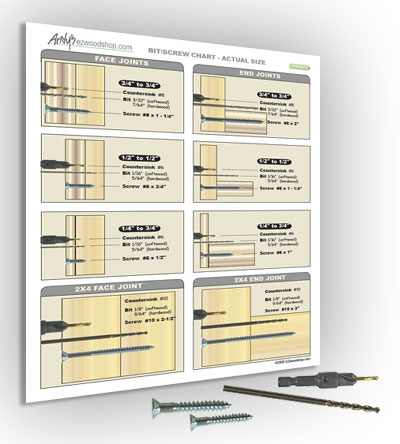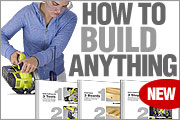
Finding the right size drill bit - to match the right size woodscrew - to match the right size board can be a challenge. My free downloadable drill bit chart takes the guesswork out of woodworking joinery by showing you the ideal combination for bits, countersinks, and woodscrews for the most common pieces of lumber you'll use in the shop.

• Actual-size diagrams make match up easy.
• Covers both face joints and end joints.
• Bit choices for both softwood and hardwood.
Let me know what you think of this chart!
Here are a few of the most common problems you'll run into when things are not properly matched:
Pilot Hole Too Large
First of all, anyone who has the forethought to drill a pilot hole first is at least on the right track. However, I think the tendency might be to choose bits that are larger than they need be. The problem is that you'll end up with hole that the woodscrew can't get a grip on. There's just not enough wood grain for the sides of the woodscrew to dig into. As a result, the two boards you're trying to join will not be pulled together as tightly as they should. You probably won't know this is happening till the head of the woodscrew goes into the board - at which point your woodscrew will spin loosely in the hole.
Pilot Hole Too Small
When you try to be a little too careful to avoid the problem I mentioned above, you can find yourself with the reverse problem. The results can be just as frustrating. The first indicator that your pilot hole is too small is when your drill starts to strip the head of the woodscrew. Sure, you can put more muscle into the drill and sometimes get the woodscrew all the way in - sometimes. But what you might not see happening is your board starting to split - from the inside out.
Woodscrew Too Large for the Board
I think we all have tendency to use woodscrews that are larger than they really need to be. Maybe we assume that bigger is always better ...always stronger, always longer lasting. However, this doesn't always hold true when joining wood boards. With most types of joinery, the purpose of the woodscrew is to simply hold two boards together while the glue dries - with the same amount gripping power I might get from a wood clamp. Believe it or not, It doesn't take a very large woodscrew to get that same level of clamping strength. It's amazing how much of a grip you can get from a woodscrew as small as 1/2."
Countersink Bits
This small item is too overlooked when people want to make just a few quick and easy woodworking joints. It's especially tempting to skip using a countersink bit when working with softwood and dimensional lumber. Sure, with enough muscle and brut force, it's possible to force the head of the woodscrew down into the face of a pine board, ut this can cause some problems, like stripped heads on woodscrews, split wood grain, and extra wear and tear on your tools. |



